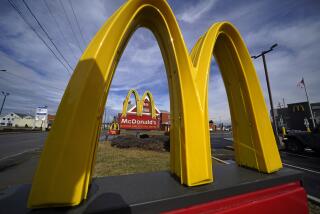McDonald’s, rivals see diminishing appeal for kids meals
- Share via
Julie Oelling’s 6-year-old daughter, Zoe, began asking to go to McDonald’s for Happy Meal toys when she started preschool two years ago.
“When she was 4, it was kind of a big thing to do, but when she turned 5, it tapered off,” Oelling said, adding that it’s been about six months since her daughter’s last request. “I’d even say she’s starting to outgrow it now depending on what the toy is.”
Long portrayed as a key contributor to childhood obesity, fast-food kids meals may be losing their appeal to youngsters — and, more importantly, their parents. The emergence of dollar menus among restaurants has given price-conscious parents a powerful incentive to choose an a la carte burger or fries rather than ponying up nearly $4 for a kids meal.
Industry observers also say the toys served up with every meal aren’t capturing older kids’ attention, while others add that children are simply aging out of the meals earlier as they’re becoming more technologically savvy.
According to the research firm NPD Group Inc., visits to fast-food restaurants in which kids meals were purchased have declined every year since 2007, falling 5% in 2011 from 2010.
Fast-food kids meals have been subject to intense scrutiny in recent years. Activist groups have zeroed in on the products and accompanying toy, saying they introduce children to a lifetime of unhealthy eating. San Francisco and a number of other cities have enacted regulations for nutritional content of fast-food kids meals when toys accompany them. A San Francisco judge earlier this month threw out a proposed class-action lawsuit seeking to ban the sale of Happy Meals in California.
Although McDonald’s is the largest player in fast food by far, most major chains, including Wendy’s, Burger King and Subway, offer kids meals. Burger King declined to comment for this story, and Wendy’s did not respond to requests for comment.
In a statement, McDonald’s spokeswoman Danya Proud said the chain is “seeing behavior shift slightly among what is being ordered” for children, “because families are eating differently than they used to when they go out.”
“Kids are curious and may share items with their parents, or they still stick to their favorite Happy Meal,” she said, adding that, “Family visits to McDonald’s remain strong and slightly higher than the rest of the industry.”
Happy Meal sales account for about 10% of McDonald’s U.S. sales, the company said, but the meal, and toys in particular, have been an important vehicle to get kids and their parents to eat at the Golden Arches. Higher incidence of family meals at fast-food restaurants tends to boost the average check, an important metric of success in the restaurant industry.
Former McDonald’s franchisee Irwin Kruger said the shift away from Happy Meals “probably more correlated with education and income, or people who have a stronger sense of the importance of a balanced meal. But you have to throw in the cost of cheaper food on the dollar menu.”
Bonnie Riggs, NPD restaurant industry analyst, agreed, noting that mothers have “probably switched to the value menu because it was cheaper than the kids meal.”
“I think there’s a lot to the idea of, ‘Let’s buy a big hamburger and cut it in half to share’ because of the economic situation,” said Barry Klein, a former McDonald’s advertising executive who now works as a marketing consultant.
Some parents move away from kids meals just to get more food.
Vandana Sharma, mother to sons Varun, 11, and Aayush, 8, said she stopped buying Happy Meals two years ago in favor of a la carte burgers and fries. A small fry is 2.5 ounces, compared with a 1-ounce portion in a kids meal, which also comes with a small side of apple slices.
“Before, they were only interested in the toy,” she said, adding that the meal went straight into the trash. “Now at least they’re eating.”
Freelance writer Cheryl V. Jackson contributed to this report.
More to Read
Inside the business of entertainment
The Wide Shot brings you news, analysis and insights on everything from streaming wars to production — and what it all means for the future.
You may occasionally receive promotional content from the Los Angeles Times.










